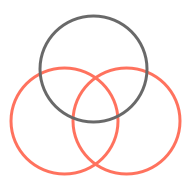Inductive Reasoning Tests
Inductive reasoning is the ability to detect generalizations, rules, or regularities1 in a certain context. For example, finding out the commonality among a group of objects, the rule for a number sequence, etc.
It provides a fundamental basis for understanding regularities of knowledge and generating concepts and categories in our daily life2 bearing a close relationship with problem-solving and establishing causal relationships3. When faced with unfamiliar problems, inductive processes are the ones that generate hypothetical rules which will be tested by further actions and observations4.
Inductive reasoning is considered a basic component of thinking, and it is one of the most broadly studied procedures of cognition with very high associations with learning, often being dubbed “learning potential”5. It encompasses the ability to transfer knowledge acquired in one context to new situations. Not surprisingly, inductive reasoning is one of the main factors predicting academic success6.
Free inductive reasoning tests:
 Abstract Reasoning Test
Abstract Reasoning Test Figure Series Test
Figure Series Test Logical Reasoning Test
Logical Reasoning Test Number Series Test
Number Series Test Verbal Reasoning Test
Verbal Reasoning TestWhat is inductive reasoning?
Inductive reasoning is a mental process through which a person analyzes particular premises to draw a general conclusion that may or may not be valid. The process of inductive reasoning goes something like this: you observe particular and unfamiliar information, you find a pattern, draw a hypothesis and formulate a theory. In this sense, it is the opposite of deductive reasoning in which we depart from a general theory to arrive at a particular premise.
For example, in an inductive reasoning test with number series, you are given a sequence of numbers without any other information. Each number is a particular premise and you must find the pattern (the rule) behind the sequence. Then you draw one or more hypotheses and test them to arrive at a conclusion (theory). In a real-life situation, the validity of the theory is not always apparent or provable, but in a test situation, you can check if it is right or wrong by looking at the possible answers.
For comparison, if the test was set to evaluate deductive reasoning, you would be given the theory first, that is, the rules governing the sequence of numbers, and be asked to arrive at a particular digit.
For a real-life situation example, imagine that you are checking a group of people trying out the same type of beverage and you see them flinch on the first gulp. The beverage and the person are the particular premises, the pattern is the flinching. You can then induce that the beverage is bitter or has a bad taste. Your theory might be right or wrong. It may be that the beverage is simply too hot or cold and the flinching has nothing to do with its taste. But that is to be proven by other reasoning skills other than induction.
Inductive reasoning is connected with abstract and conceptual reasoning. In simple terms, it is the skill that allows you to “think outside the box” and to “read a room”.
Tips to solve inductive reasoning tests
Practice inductive reasoning tests
Practicing will help you become more familiar and comfortable with the inductive thinking process. It will also help you train this skill in an overall manner.
Inductive reasoning tests can use more than one type of question to evaluate the test-takers. Through practice, you will get to know the type of exercises you might face and their purpose. You will also become aware of the trail of thought they require in order to be solved.
Don’t get distracted by irrelevant information
Keep in mind that some questions may be designed to try to trick you into inducing a false pattern or hypothesis. The goal is to ensure an accurate assessment of your reasoning skills, which includes the ability to spot these tricks and to sort the information into what is relevant and what is not.
Try to arrive at the solution before looking at the answers
It is not only the questions that may contain “planted” information to trick you into making a mistake in your reasoning. The possible answers are also designed to be purposefully confusing.
Test makers normally use two strategies when it comes to the possible answers. Either they make them so unrelated and with values or figures so different and far apart that makes you wonder what is going on and if there is something that you are failing to see; or they make them so similar that, at first glance, there seems to be more than one answer that could be right.
To avoid any of these pitfalls, try to focus solely on the question itself and in solving the exercise. Once you believe that you have found the right answer, look for it among the options available, select it and move on to the next question. Do not dwell on the remaining options or you might start doubting yourself.
Work the sequences backward
This is a good tip when facing questions with sequences for which you need to induce the rule governing them to find the missing figure or digit. Instead of adding an unknown to your thinking process, try to work only with what is known to you.
In other words, instead of thinking “What is next?” try to deconstruct the sequence already in front of you. Once you discover the rule governing it, you will find the answer naturally.
References:
1 Klauer, K. & Phye, G. (2008). Inductive Reasoning: A Training Approach. Review of Educational Research. 78(1), 85–123.
2 Klauer & Phye, 2008
3 Vo, D & Csapó, B. (2020). Development of inductive reasoning in students across school grade levels. Thinking Skills and Creativity, 37, 100699
4 Perret, P. (2015). Children’s inductive reasoning: Developmental and educational perspectives. Journal of Cognitive Education and Psychology, 14(3), 389-408
5 Tissink, Hamers, & van Luit, (1993) cit in Csapó, B. (1997). The Development of Inductive Reasoning: Cross-sectional Assessments in an Educational Context. International journal of behavioral development. 20 (4), 609–626.
6 Vo & Csapó, 2020